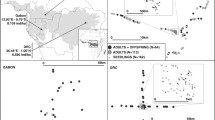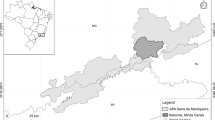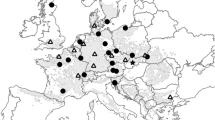Abstract
Additive variation in adaptive traits is a prerequisite for selectionand adaptation to future environmental changes, but distribution of adaptivegenetic variability between and within populations is poorly known in mostforest trees. Owing to this deficiency, life history traits such as geographicrange, pollination vector and seed dispersal capability, which significantlyaffect gene flow and thus the distribution of genetic variability, were used toevaluate the genetic resources in 23 Norwegian native forest tree species. Basedon the combination of life history traits the species' genetic resourceswere classified either as viable, potentially vulnerable or vulnerable, assuminga decrease in within-population variability in this sequence. Twelve widelydistributed species with generally effective dispersal of pollen and seeds wereconsidered viable (Pinus sylvestris, Picea abies,Juniperus communis, Betula pubescens, B. pendula,Alnus incana, A. glutinosa, Salix caprea, Populustremula, Corylus avellana, Sorbus aucuparia, Prunus padus)and have as such no particular conservation needs. Effective seed dispersal of these species, asinferred from post-glacial migration rates, may be partly responsible for theirgenerally early post-glacial appearance, and may, in combination with the wideranges and relatively large evolutionary potential, indicate that viable speciesare best able to cope with climatic change. Among species with restricted rangesand more limited gene flow eight were considered potentially vulnerable (Quercuspetraea, Q. robur, Fraxinus excelsior, Acer platanoides,Taxus baccata, Ilexaquifolium, Fagus sylvatica, Ulmus glabra) and threewere considered vulnerable (Tiliacordata, Malus sylvestris, P. avium). Application of differentintensities of a multiple population breeding system (MPBS) is considered the most appropriate mode of conservinggenetic resources in these species.
Similar content being viewed by others
References
Bacilieri R., Labbe T. and Kremer A. 1994. Intraspecific genetic structure in mixed populations of Quercus petraea (Matt.) Liebl. and Q.robur L. Heredity 73: 130–141.
Baliuckas V., Ekberg I., Eriksson G. and Norell L. 1999. Genetic variation among and within populations of four Swedish hardwood species assessed in a nursery trial. Silvae Genetica 48: 17–25.
Baliuckas V., Lagerström T. and Eriksson G. 2000. Within-population variation in juvenile growth rhythm and growth in Fraxinus excelsior L. and Prunus avium L. Forest Genetics 7: 193–202.
Boshier D.H. 2000. Mating systems. In: Young A., Boshier D. and Boyle T. (eds), Forest Conservation Genetics. CABI Publishing, Wallingford, UK, pp. 63–79.
Bradshaw H.W., Holmquist B.H., Cowling S.A. and Sykes M.T. 2000. The effect of climate change on the distribution and management of Picea abies in southern Scandinavia. Canadian Journal of Forest Research 30: 1992–1998.
Crawford R.M.M. 1989. Studies in Plant Survival. Blackwell Scientific Publications, Oxford, UK.
Eriksson G. 1996. Evolutionary genetics and conservation of forest genetic resources. In: Turok J., Eriksson G., Kleinschmit J. and Canger S. (eds), Noble Hardwoods Network. Report of the first meeting, Escherode, Germany, 24–27 March 1996. International Plant Genetic Resources Institute, Rome, Italy, pp. 159–167.
Eriksson G. 1998a. Evolutionary forces influencing variation among populations of Pinus sylvestris. Silva Fennica 32: 173–184.
Eriksson G. 1998b. Sampling for genetic resources populations in the absence of genetic knowledge. In: Turok J., Collin E., Demesure B., Eriksson G., Kleinschmit J., Rusanen M. et al. (eds), Noble Hardwoods Network. Report of the second meeting, Lourizàn, Spain, 22–25 March 1997. International Plant Genetic Resources Institute, Rome, Italy, pp. 48–50.
Eriksson G. 1999. Global warming and gene conservation in Noble Hardwoods. In: Turok J., Jensen J., Palmberg-Lerche Ch., Rusanen M., Russell K., de Vries S. et al. (eds), Noble Hardwoods Network. Report of the third meeting, Sagadi, Estonia, 13–16 June 1998. International Plant Genetic Resources Institute, Rome, Italy, pp. 98–112.
Eriksson G. 2000. To survive and not survive global warming? In: Turok J. and Geburek T. (eds), International collaboration on forest genetic resources: the role of Europe, Proceedings of the Second EUFORGEN Steering Committee Meeting, Vienna, Austria, 26–29 November 1998. International Plant Genetic Resources Institute, Rome, Italy, pp. 36–43.
Eriksson G. 2001. Conservation of noble hardwoods in Europe. Canadian Journal of Forest Research 31: 557–587.
Eriksson G. and Jonsson A. 1986. A review of genetics of Betula. Scandinavian Journal of Forest Research 1: 421–434.
Eriksson G., Namkoong G. and Roberds J.H. 1993. Dynamic gene conservation for uncertain futures. Forest Ecology and Management 62: 15–37.
Frison E.F., Lefevre F., de Vries S. and Turok J. 1995. Populus nigra Network. Report of the first meeting, Izmit, 3–5 October 1994. International Plant Genetic Resources Institute, Rome, Italy.
Govindaraju D.R. 1988. Relationship between dispersal ability and levels of gene flow in plants. Oikos 52: 31–35.
Hamrick J.L. and Godt M.J.W. 1990. Allozyme Diversity in Plants. In: Brown H.D., Clegg M.T., Kahler A.L. and Weir B.S. (eds), Plant Population Genetics, Breeding, and Genetic Resources. Sinauer Associates Inc., Sunderland, Massachusetts, pp. 43–63.
Hamrick J.L. and Godt M.J.W. 1996. Effects of life history traits on genetic diversity in plant species. Philosophical Transactions of the Royal Society of London. Series B, Biological Sciences 351: 1291–1298.
Hamrick J.L. and Nason J.D. 1996. Consequences of dispersal in plants. In: Rhodes O.E., Chesser R.K. and Smith M.H. (eds), Population Dynamics in Space and Time. The University of Chicago Press, Chicago, Illinois, pp. 203–236.
Hamrick J.L. and Nason J.D. 2000. Gene flow in forest trees. In: Young A., Boshier D. and Boyle T. (eds), Forest Conservation Genetics. CABI Publishing, Wallingford, UK, pp. 81–89.
Hamrick J.L., Godt M.J.W. and Sherman-Broyles S. 1992. Factors influencing levels of genetic diversity in woody plant species. New Forests 6: 95–124.
Hamrick J.L., Murawski D.A. and Nason J.D. 1993. The influence of seed dispersal mechanisms on the genetic structure of tropical tree populations. Vegetatio 107/ 108: 281–297.
Heuertz M., Hausman J.-F., Tsvetkov I., Frascaria-Lacoste N. and Vekemans X. 2001. Assessment of genetic structure within and among Bulgarian populations of the common ash (Fraxinius excelsior L.). Molecular Ecology 10: 1615–1623.
Hewitt G.M. 1999. Post-glacial re-colonisation of European biota. Biological Journal of the Linnean Society 68: 87–112.
Holsinger K.E. and Gottlieb 1991. Conservation of rare and vulnerable plants. In: Falk D.A. and Holsinger K.E. (eds), Genetics and Conservation of Rare Plants. Oxford University Press, Oxford, UK, pp. 195–223.
Hultén E. 1971. Atlas of the Distribution of Vascular Plants in Northwestern Europe. Generalstabens litagrafiske anstalts forlag, Stöckholm, Sweden.
Hultén E. and Fries M. 1986. Atlas of North EuropeanVascular Plants North of the Tropic of Cancer.Vol. I–III. Koeltz Scientific Books, Konigstein, Germany.
Huntley B. 1991. How plants respond to climate change: migration rates, individualism and the consequences for plant communities. Annales of Botany 67: 15–22.
Huntley B. and Birks H.J.B. 1983. An Atlas of Past and Present Pollen maps for Europe: 0–13000 BP. Cambridge University Press, Cambridge, UK.
IPCC 1995. Second Assessment Report: Climate Change. Report of the Intergovernmental Panel on Climate Change. IPCC, Geneva, Switzerland.
Johnsen Ø. and Østreng G. 1994. Effects of plus tree selection and seed orchard environment on progenies of Picea abies. Canadian Journal of Forest Research 24: 32–38.
Karhu A., Hurme P., Karjalainen M., Korvonen P., Karkkainen P., Neale D. et al. 1996. Do molecular markers reflect patterns of differentiation in adaptive traits of conifers? Theoretic and Applied Genetics 93: 215–221.
Ketner P. 1990. Impact of climate change on flora and vegetation in western Europe with special emphasis on the Netherlands. In: Holten J.I. (ed.), Effects of Climate Change on Terrestrial Ecosystems. Norsk institutt for naturforskning, Notat 4, Trondheim, Norway, pp. 47–66.
Kremer A. and Zanetto A. 1997. Geographic structure of gene diversity in Quercus petraea (Matt.) Liebl. II: multilocus patterns of variation. Heredity 78: 476–489.
Kullman L. 1995. New and firm evidence for MidHolocene appearance of Picea abies in the Scandes Mountains, Sweden. Journal of Ecology 83: 439–447.
Kullman L. 1996. Norway spruce present in the Scandes Mountains, Sweden at 8000 BP: new light on Holocene tree spread. Global Ecology and Biogeography Letters 5: 94–101.
Kullman L. 1998. Non-analogous tree flora in the Scandes Mountains, Sweden, during the early Holocene — macrofossil evidence of rapid geographic spread and response to paleoclimate. Boreas 27: 153–161.
Lang G. 1994. Quartäre Vegetationsgeschichte Europas — Methoden und Ergebnisse. Gustav Fischer Verlag, Jena, Germany.
Lindgren D., Paule L., Xihuan S., Yazdani R., Segerstrom U., Wallin J.-E. et al. 1995. Can viable pollen carry Scots pine genes over long distances? Grana 34: 64–69.
Michaud H., Toumi L., Lumaret R., Li T.X., Romane F. and Digiusto F. 1995. Effect of geographic discontinuity on genetic variation in Quercus ilex L. (Holm oak) – evidence from enzyme polymorphism. Heredity 74: 590–606.
Moe D. 1970. The post-glacial migration of Picea abies into Fennoscandia. Botaniske Notiser 123: 61–66.
Moe D., Vorren K.-D., Alm T., Fimreite S., Mørkved B., Nilssen E. et al. 1996. Norway. In: Berglund B.E., Birks H.J.B., Raska-Jasiewiczowa M. and Wright H.E. (eds), Paleoecological Events During the Last 15000 Years. Regional Synthesis of Paleoecological Studies of Lakes and Mires in Europe. Wiley, Weinheim, Germany, pp. 153–213.
Mosseler A., Egger K.N. and Hughes G.A. 1992. Low levels of genetic diversity in red pine confirmed by random amplified polymorphism DNA markers. Canadian Journal of Forest Research 22: 1332– 1337.
Möller-Stark G., Baradat P. and Bergmann F. 1992. Genetic variation within European tree species. New Forests 6: 23–47.
Myking T. and Skrøppa T. 2001. Bevaring av genetiske ressurser hos norske skogstrær [Conservation of genetic resources in Norwegian forest trees] (in Norwegian with English abstract). Aktuelt fra skogforskningen 2: 1–44.
Namkoong G. 1984. A control concept of gene conservation. Silvae Genetica 33: 160–163.
Nason J.D. and Hamrick J.L. 1997. Reproductive and genetic consequences of forest fragmentation: two case studies of neutropical canopy trees. Journal of Heredity 88: 264–276.
NIJOS 1994. Statistikk over skogforhold i Norge [Statistics of Forest Conditions and Resources in Norway] (in Norwegian with English abstract). Norwegian Institute of Land Inventory, Ås, Norway.
Oldfield S., Lusty C. and MacKinven A. 1998. TheWorld List of Threatened trees. World Conservation Press, WCMC, Cambridge, UK.
Persson B. and Ståhl E.G. 1990. Survival and yield of Pinus sylvestris L. as related to provenance transfer and spacing at high altitudes in northern Sweden. Scandinavian Journal of Forest Research 5: 381–395.
Peters R.L. 1990. Effects of global warming on forests. Forest Ecology and Management 35: 13–33.
Peters R.L. 1991. Consequences of global warming for biological diversity. In: Wyman R.L. (ed.), Global Climate Change and Life on Earth. Chapman & Hall, New York, pp. 99–118.
Pigott C.D. and Huntley J.P. 1981. Factors controlling the distribution of Tilia cordata at the northern limits of its geographic range. III. Nature and causes of seed sterility. New Phytologist 87: 817–839.
Rabinowitz D. 1981. Seven forms of rarity. In: Synge H. (ed.), The Biological Aspects of Rare Plant Conservation. Wiley, Chichester, UK, pp. 205–217.
Rehfeldt G.E. and Lester D.T. 1969. Specialization and flexibility in genetic systems of forest trees. Silvae Genetica 18: 118–123.
Roberts L. 1989. How fast can trees migrate? Science 243: 735–737.
Rusanen M., Vakkari P. and Blom A. 2000. Evaluation of the Finnish gene-conservation strategy for Norway maple (Acer platanoides L.) in the light of allozyme variation. Forest Genetics 7: 155–165.
Sæbø A. and Johnsen Ø. 2000. Growth and morphology differ between wind-exposed families of Sorbus aucuparia (L.). Journal of Arboriculture 26: 255–262.
Salvesen P.H. 1996. Seedset and fruit development in Tilia cordata Mill. in Norway. In: Nordahl I. (ed.), Seed, Fruit, Fertility. I. Det norskeVidenskaps-Akademi. Mat. Naturv. Klasse, Avhandlinger Ny serie 18: pp. 45–52.
Savolainen O. 2000. Guidelines for gene conservation based on population genetics. In: Krishnapillay B., Soepadmo E., Arsrad N.L., Wong A., Appanah S., Wan Chik S. et al. (eds), Forests and Society: The Role of Research, XXI IUFRO World Congress, Kuala Lumpur, Malaysia, 7–12 August 2000. Pramaju Sdn. Bhd. Malaysia, pp. 100–109.
Savolainen O. and Kuittinen H. 2000. Small population processes. In: Young A., Boshier D. and Boyle T. (eds), Forest Conservation Genetics. CABI Publishing, Wallingford, UK, pp. 91–100.
Skrøppa T. 1991. Within-population variation in autumn frost hardiness and its relationships to bud-set and height growth in Picea abies. Scandinavian Journal of Forest Research 6: 353–363.
Skrøppa T. and Dietrichson J. 1986. Winter damage in the IUFRO 1964–1968 provenance experiment with Norway spruce (Picea abies (L.) Karst.). Communications of the Norwegian Forest Research Institute 39: 161–183.
Slatkin M. 1985. Gene flow in natural populations. Annual Review of Ecology and Systematics 16: 393–430.
Sonesson J. and Eriksson G. 2000. Genotype stability and genetic parameters for growth and biomass traits in a water 3 temperature factorial experiment with Pinus sylvestris L. seedlings. Forest Science 46: 487–495.
Stern K. and Roche L. 1974. Genetics of Forest Ecosystems. Ecological Studies 6. Springer, Berlin.
Sykes M.T. and Prentice I.C. 1996. Climate change, tree species distributions and forest dynamics: a case study in the mixed conifer / northern hardwoods zone of northern Europe. Climatic Change 34: 161–177.
Turok J., Collin E., Demesure B., Eriksson G., Kleinschmit J., Rusanen M. et al. 1998. Noble Hardwoods Network. Report of the second meeting, Lourizán, Spain, 22–25 March 1997. International Plant Genetic Resources Institute, Rome, Italy.
UNEP 1992. United Nations Environmental Program. Convention on Biological Diversity. UNEP/BIO./ CONF/ L.
Author information
Authors and Affiliations
Rights and permissions
About this article
Cite this article
Myking, T. Evaluating genetic resources of forest trees by means of life history traits – a Norwegian example. Biodiversity and Conservation 11, 1681–1696 (2002). https://doi.org/10.1023/A:1016814817208
Issue Date:
DOI: https://doi.org/10.1023/A:1016814817208




